Book contents
- Frontmatter
- Contents
- Preface
- Editors' Introduction: Inference and Shoe Leather
- Part I Statistical Modeling: Foundations and Limitations
- Part II Studies in Political Science, Public Policy, and Epidemiology
- 4 Methods for Census 2000 and Statistical Adjustments
- 5 On “Solutions” to the Ecological Inference Problem
- 6 Rejoinder to King
- 7 Black Ravens, White Shoes, and Case Selection: Inference with Categorical Variables
- 8 What is the Chance of an Earthquake?
- 9 Salt and Blood Pressure: Conventional Wisdom Reconsidered
- 10 The Swine Flu Vaccine and Guillain-Barré Syndrome: A Case Study in Relative Risk and Specific Causation
- 11 Survival Analysis: An Epidemiological Hazard?
- Part III New Developments: Progress or Regress?
- Part IV Shoe Leather Revisited
- References and Further Reading
- Index
11 - Survival Analysis: An Epidemiological Hazard?
Published online by Cambridge University Press: 05 June 2012
- Frontmatter
- Contents
- Preface
- Editors' Introduction: Inference and Shoe Leather
- Part I Statistical Modeling: Foundations and Limitations
- Part II Studies in Political Science, Public Policy, and Epidemiology
- 4 Methods for Census 2000 and Statistical Adjustments
- 5 On “Solutions” to the Ecological Inference Problem
- 6 Rejoinder to King
- 7 Black Ravens, White Shoes, and Case Selection: Inference with Categorical Variables
- 8 What is the Chance of an Earthquake?
- 9 Salt and Blood Pressure: Conventional Wisdom Reconsidered
- 10 The Swine Flu Vaccine and Guillain-Barré Syndrome: A Case Study in Relative Risk and Specific Causation
- 11 Survival Analysis: An Epidemiological Hazard?
- Part III New Developments: Progress or Regress?
- Part IV Shoe Leather Revisited
- References and Further Reading
- Index
Summary
Abstract. Proportional-hazards models are frequently used to analyze data from randomized controlled trials. This is a mistake. Randomization does not justify the models, which are rarely informative. Simpler methods work better. This discussion is salient because the misuse of survival analysis has introduced a new hazard in epidemiology: It can lead to serious mistakes in medical treatment. Life tables, Kaplan-Meier curves, and proportional-hazards models, aka “Cox models,” all require strong assumptions, such as stationarity of mortality and independence of competing risks. Where the assumptions fail, the methods also tend to fail. Justifying those assumptions is fraught with difficulty. This is illustrated with examples: the impact of religious feelings on survival and the efficacy of hormone replacement therapy. What are the implications for statistical practice? With observational studies, the models could help disentangle causal relations if the assumptions behind the models can be justified.
In this chapter, I will discuss life tables and Kaplan-Meier estimators, which are similar to life tables. Then I turn to proportional-hazards models, aka “Cox models.” Along the way, I will look at the efficacy of screening for lung cancer, the impact of negative religious feelings on survival, and the efficacy of hormone replacement therapy.
What are the conclusions about statistical practice? Proportional-hazards models are frequently used to analyze data from randomized controlled trials.
- Type
- Chapter
- Information
- Statistical Models and Causal InferenceA Dialogue with the Social Sciences, pp. 169 - 192Publisher: Cambridge University PressPrint publication year: 2009
- 1
- Cited by



